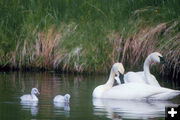Respect nesting Trumpter Swans
by Wyoming Game & Fish
May 22, 2012
Trumpeter swans in western Wyoming have responded to the warm spring weather this year by initiating nesting early at many traditional sites. Most years, wild pairs will start sitting on eggs the third week of May or later. A few swans, however, started to incubate as early as the first week of May in 2012. The female swan must keep her eggs warm for 32 days before the young hatch. She will leave the nest only for brief periods during the day to feed and bathe.
"If you see swans raise their heads high and hear them start calling, you are too close," says Susan Patla, Jackson Nongame Biologist for the Wyoming Game and Fish Department. Patla requests that wildlife observers take care this time of year to avoid disturbing nesting pairs.
"This may cause a female to swim away from her nest, leaving eggs exposed to heat and predators." Patla emphasized that individual swans respond very differently to human disturbance with some much more tolerant than others. "It is best to stay away from swans that are on nests or have small young, as loss of eggs or young can happen very quickly." Keeping dogs under control in wetland habitat is important as well to avoid disturbance to many species of birds that nest and feed in wetlands in addition to swans.
Although the trumpeter swan is one of the most widely recognized and appreciated bird species in the state, it is one of Wyoming’s least common nesting species. In fact, it is far easier to see swans in winter than summer, as this is one of the few species that occur in Wyoming in much greater numbers in winter than in summer. This past winter, biologists counted over 1000 swans wintering in the Snake, Salt, Green, and Wind River drainages in Wyoming. Over half of these wintering swans were found in the Jackson area. In contrast, the year-round resident population counted during the annual fall aerial survey totaled only 124 adults and 37 young in 2011.
The Wyoming Game and Fish Department has worked with many partners since the 1990s to expand both the summer and winter distribution in western Wyoming. A range expansion project in the Green River basin has been very successful. The last few years, swans have occupied more nest sites and produced more young in the Green River basin than in the historical nesting habitat around Jackson. Last year, swans laid eggs at 14 sites in the Green River expansion area compared to only 10 pairs that nested in the Snake River drainage.
"Every potential swan nest site is valuable given their low numbers," said Patla. "This year could produce a bumper crop of cygnets (young swans) if the good weather continues." The Wyoming Game and Fish Department’s conservation efforts for swans include managing for secure nesting and wintering habitat, reducing mortality where possible by marking power lines and fences, and working with landowners and other agencies to create additional summer wetland habitat. Management prescriptions are available from Game and Fish upon request on how to construct ponds suitable for swans and other wetland wildlife.
|
